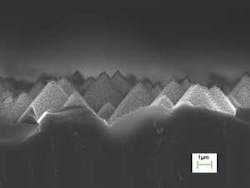Superhydrophobic surface improves solar cells in two ways
The absorption efficiency of solar cells can be improved through surface patterning and antireflective coatings, among other methods in development. Adding to this list is a superhydrophobic surface developed by researchers at the Georgia Institute of Technology (Atlanta, GA) that both naturally sheds water (washing away dirt and dust) and better traps light in its three-dimensional surface structure, improving collection efficiency.
The superhydrophobic surface mimics the lotus leaf and consists of both micro- and nanoscale structures with high contact angles and low hysteresis that encourage water to bead up and run off. Surface preparation begins with a potassium hydroxide solution etch that preferentially removes silicon along crystalline planes, creating micron-scale pyramidal structures. Nanometer-scale gold particles are then applied and used as the catalyst for a metal-assisted etching process to produce nanometer-scale features that reduce overall surface reflection to less than 5%. Although robustness of the surface needs to be improved and large-scale manufacturing viability needs to be explored for solar cells, the treatment could also be used for antibacterial coatings on medical equipment and improved microfluidic devices. Contact C. P. Wong at [email protected].
